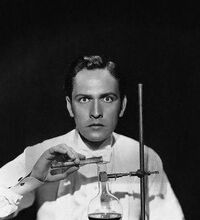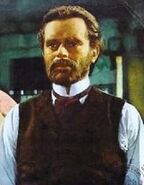Henry Jekyll is a fictional scientist and the eponymous protagonist from the 1886 novel The Strange Case of Dr. Jekyll and Mr. Hyde by author Robert Louis Stevenson. The character is generally presented as a member of upper-crust English society during the Victorian era who divines a process by which he believes he can separate the good and moral side of a man's persona from that of his evil, more primordial nature. Naturally, he cocks the whole thing up. After developing a serum that he believes will provide him with the desired results, he does the one thing that all well-meaning crackpots are wont to do and drinks the damn mess himself. Instead of excising icky bad-bad feelings from his brain, he instead physically transforms into a brutish misanthrope who assumes the name of Edward Hyde.
In film[]
The story of Dr. Jekyll and Mr. Hyde has been adapted into film more often than any story has a right to be. There were several minor independent film works produced throughout the early 1900s, but the first major film adaptation was in 1920 when John S. Robertson directed a silent film based on the story titled just Dr. Jekyll and Mr. Hyde. In this film, the role of both Henry Jekyll and Edward Hyde were played by actor John Barrymore.
The second film adaptation of the novel, also released in 1920, was directed by J. Charles Hayden, and featured Sheldon Lewis pulling in double-time as Doc Jekyll and his more unsavory antithesis, Edward "Big Eddie" Hyde.
Of the classic film era, only one other rendition of this tale resonates with the public consciousness, and that was the 1941 movie, Dr. Jekyll and Mr. Hyde, directed by silver screen giant Victor Fleming. In this movie, the role of Doctor Henry Jekyll, as well as that of Edward Hyde, was portrayed by actor Spencer Tracy.
Actor Boris Karloff, often cited as an iconic figure of classic horror, took the form of the good doctor in a humorous vein. Karloff drank the wacky Jekyll juice for 1953's Abbott and Costello Meet Dr. Jekyll and Mr. Hyde, directed by Charles Lamont.
Naturally, you cannot have a Gothic Victorian-era style of horror tale going around without Hammer Film Productions getting into the mix. They spun their own version of the tale in 1960 with a movie directed by Terence Fisher called The Two Faces of Dr. Jekyll, making it one of the first films to deviate from the traditional Dr. Jekyll and Mr. Hyde naming convention. This time around, the good doctor and his not-so-better half were played by British actor Paul Massie.
Hammer wasn't quite done with the Jekyll & Hyde concept though. They revisited it in 1971 with a movie titled, Dr. Jekyll and Sister Hyde. For the first time ever, the Jekyll & Hyde motif underwent a bit of gender flipping, and as such, is one of the first examples of Henry Jekyll and Edward Hyde (or in this case, Edwina Hyde), being played by two different actors. Hammer staple Ralph Bates assumed the role of Henry Jekyll with Martine Beswick taking on the form of his more voluptuous counterpart, Sister Hyde.
An often forgotten, yet respectable take on this classic story unfolded in the form of the 1996 drama Mary Reilly starring Julia Roberts. The story is revealed through the point of view of Henry Jekyll's housemaid, Mary Reilly, with John Malkovich methodically shifting through his scenes as a somewhat soft-spoken, yet still creepy in a truly Malkovichian way, Henry Jekyll.
The 2000s have not been particularly kind to fans of Robbie Lou Stevie's favorite schizo. First, the world was treated to a valium-induced and unforgivable CGI-rendered Mister Hyde in League of Extraordinary Gentleman. Remember that piece of crap? Jason Flemyng played the part of Henry Jekyll and moderately doubled as Mister Hyde courtesy of some early pre-motion capture magic. Another version of Jekyll and Hyde, who bore an odd similarity to the LXG version, appeared in the beginning of 2004's monster mash excrapaganza, Van Helsing. While most viewers were "ooh-ing" and "ahh-ing" over the badassery of Hugh Jackman, they likely forgot Stephen H. Fisher's microscopic portrayal of a dying Henry Jekyll.
Only a few short years later, a more modern take on the Jekyll & Hyde story was brought to life in the form of a television movie, Dr. Jekyll and Mr. Hyde, which was directed by Paolo Barzman and aired on May 17th, 2008. This time around, it was Dougray Scott's turn to take on the challenging role of the Doctor.
Doctor Jekyll[]
Notes & Trivia[]
- Doctor Henry Jekyll and Dr. Henry Jekyll both redirect to this page.
- In addition to the numerous interpretations of the character, there have also been a number of Jekyll & Hyde pastiches over the years.
- Without question, the most famous pastiche of Henry Jekyll in all of pop culture is one mister Robert Bruce Banner. Having been pelted by Gamma Rays, Doc Bruce Banner turned into a multi-ton green Gargantua that the world has come to know as the incredible Hulk. Like Doctor Jekyll, the Banner archetype is that of a soft-spoken, morally-centered educated man, whose own ambitions get the better of him, and is transformed into a monster as a result of his own scientific handiwork.
- Another pastiche of the diabolical duo was brought to life in the 1960s Gothic soap opera series Dark Shadows. In a storyline that involved a parallel timeline, there was a character named Cyrus Longworth (played by Christopher Pennock), who developed a formula that, when consumed, changed the color of his hair and gave him a wicked-ugly mustache. Under this particular Hyde effect, Longworth began calling himself John Yaeger.
- In 2007, the BBC aired a six-part miniseries event called Jekyll. The show starred James Nesbitt as Doctor Tom Jackman (as well as Mister Hyde), who was a modern-era scientist with a strange connection to his more infamous literary progenitor.
See also[]
External Links[]
- Henry Jekyll at IMDB
- Henry Jekyll at Wikipedia
- Henry Jekyll at the LXG Wiki
- Henry Jekyll at the Villains Wiki
| This article relates to the Doctor Jekyll and Mister Hyde franchise. This template will categorize articles that include it in into the Jekyll and Hyde miscellaneous category. |




